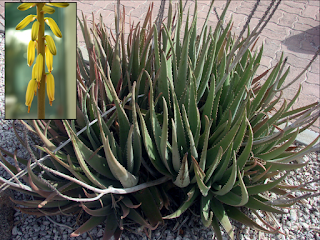 |
| Aloe vera Image courtesy: MidgleyDJ/Wikimedia Commons (CC BY-SA 3.0) |
Scientific Classification
Kingdom : PlantaeOrder : Asparagales
Family : Asphodelaceae
Genus : Aloe
Species : vera
Binomial name : Aloe vera L.
It grows mainly in the dry regions of Asia, Africa, America and Europe.
Aloe vera is a stemless plant growing up to 60-100 cm. The leaves are thick, fleshy and contain spines at the margins (serrated edges). The yellow tubular flowers are produced in summer on a spike up to 90 cm tall.
- Aloe is used as purgative.
- It is one of the ingredients of skin lotions, cosmetics and ointments. The ointment of aloe-gel is used to cure burns caused by heat, sun or radiation and skin irritations.
- It is also used as an ornamental plant.

No comments:
Post a Comment